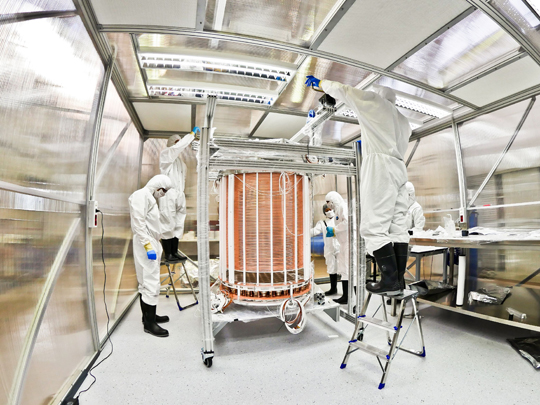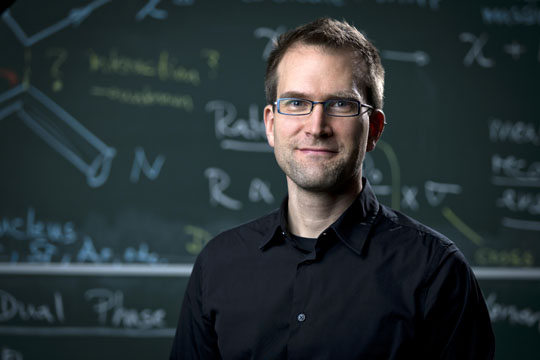Longer Than the Universe Has Existed
Freiburg, May 23, 2019
The Big Bang was an extremely long time ago. Yet it seems like only the blink of an eye compared to the half-life of the isotope Xenon-124, which is trillions of years longer than the age of the universe. Researchers from the University of Freiburg working with the international XENON Experiment were able measure this half-life and set a spectacular new record.
 Thanks to the XENON1T detector, researchers were able to observe the radioactive decay with the longest half-life ever measured.
Thanks to the XENON1T detector, researchers were able to observe the radioactive decay with the longest half-life ever measured.
Photo: The XENON1T Experiment
The half-life of Xenon-124 is 1.8 times 1022 years! That is a long time – one trillion times longer than the universe has existed. This number sounds so absurd that you might think that no decay has happened since the Big Bang roughly 14 billion years ago. “That’s not the case,” says Prof. Dr. Marc Schumann, an experimental astroparticle physicist from the Institute of Physics of the University of Freiburg. Schumann works with the international XENON project, where he was able to observe this decay with the longest half-life ever measured. This new world record was sensational enough to make the cover story of Nature. According to Schumann, this proves just how spectacular these findings were. “Otherwise, journals like Nature and Science are never interested in our research.”
A thermos deep in the rocks serves as a detector
Speaking of different half-lives, the longest half-life belongs to the isotope Tellurium-128. However, this was only indirectly deduced by geophysicists using other Tellurium half-lives as a basis – its own half-life was not actually measured. “It’s most likely correct,” Schumann says. What he can be certain of, however, is the half-life of Xenon-124, or 124Xe. The isotope of the noble gas Xenon decays with a – measured – half-life of 1.8 x 1022 years. How is this measurement possible if decay is such a rare event? The half-life of a substance indicates how long it takes for half of it to decay. In other words, one half decays before its half-life, and the other half decays after. Decay begins immediately. In order to measure the rare decay of the Xenon isotope, scientists need large amounts of 124Xe, as well as suitable detectors.
 The Grand Sasso Mountains in Italy: This is where the experiment is located, 1,500 meters deep within the rock, to protect it from cosmic rays.
The Grand Sasso Mountains in Italy: This is where the experiment is located, 1,500 meters deep within the rock, to protect it from cosmic rays.
Photo: MrPanyGoff/Wikimedia Commons CC BY-SA 4.0
Both can be found 1,500 meters deep below the rocky surface of the Grand Sasso Mountains in Italy, where the XENON1T experiment has its headquarters. Schumann’s research group not only developed important components for the detector, they also developed the data screening system and were involved in the analysis. XENON1T resembles a kind of supersized thermos. Its heart is a cylindrical tank equipped with 248 highly sensitive light sensors at its upper and lower ends. These sensors receive signals from inside the tank, which is filled with two tons of liquid Xenon kept at a temperature of -95° Celsius. Because one tenth of one percent of natural Xenon is 124Xe, this mass includes a large amount of the isotope. “So much, that some of it has to decay each year,” the astroparticle physicist says.
The researchers detected 126 events, or double electron captures, of 124Xe below ground. Double electron capture is the scientific term for radioactive decay. The main problem is not whether double electron captures occur, but being able to measure them. “Other detectors were too small and not clean enough,” says Schumann. Unclean means that the noise floor – all unwanted noise – caused by background signals is too high, masking the rare decay signals. Not only does the internal Xenon decay produce signals that can be measured; so do all particles from outside that hit a Xenon nuclei in the cylinder. That is why XENON1T is buried 1.5 kilometers below the rocky surface and is surrounded by a large water tank, because this way it is shielded from cosmic rays and the neighboring research lab.
Blind analysis avoids the influence of expectations
What remains is the natural radioactivity that all materials emit – even the elements within the detector. The goal is to minimize and measure this radiation, the intensity of which is constant. “The background it causes is completely flat,” says Schumann, referring to measuring points connected by a straight line on a graph. This must be low enough that the decay signals stand out. That they did actually stand out is indicated by the sharp curve of measuring points, Schumann adds. “We got a clearly visible signal,” he says. But how does he know it is from the decay of 124Xe?
 Marc Schumann, an astroparticle physicist at the University of Freiburg, wants to continue building the best possible detectors. Photo: Jürgen Gocke
Marc Schumann, an astroparticle physicist at the University of Freiburg, wants to continue building the best possible detectors. Photo: Jürgen Gocke
“That’s the critical issue,” he admits. In order to prove this beyond doubt, the XENON collaboration uses several safeguarding measures. For example, human nature is taken out of the equation, because it is a well-known fact that expectations can bias objectivity. “Measuring this half-life was the goal of the experiment, after all,” says Schumann, which is why the experts had to precisely determine the background radiation in the area of measurement as well as the type of signal they hoped to find without ever having seen any data from this segment. “The analysis was conducted blindly,” explains Schumann, who is an expert in detectors. This means that the detector’s calculations and calibrations had to be done in a slightly roundabout way, and the analysis of the area of data where scientists hoped to find the signal began only after the fact.
XENON1T works by detecting light. When 124Xe decays, X-rays are emitted, which make some Xenon nuclei emit light. However, XENON1T also measures minute electric charges. While these are also emitted during such events, they are much slower than light. “Based on the time difference between these two signals, we can calculate the position where a decay occurred in the detector,” says Schumann. More importantly, the signals had the expected energy. After a group of scientists brooded over the data for more than a year, the result was clear: The signals are from 124Xe decays. Based on the number of decays that occurred during the measuring period and related to the overall amount of 124Xe, the extremely long half-life were able to be calculated.
The researchers want to be world champions in detector sensitivity
“It is nice to have achieved that measurement,” Schumann remarks. “We’re happy.” But beyond that, the world record is not so important in that it does not shed any new light on dark matter, although almost one quarter of the universe is made out of this inexplicable substance. “That would have been a measurement worthy of a Nobel prize,” says Schumann, who wrote his PhD thesis on particle physics. While completing his second postdoc in Houston, Texas, he became interested in astroparticle physics, a field in which researchers do not artificially produce particles but study those already existing in the universe. “My motivation is to build the best detectors possible,” says Schumann, who became a professor in Freiburg in 2016 and is now the head of a research group of 20 scientists.
XENON1T is the third model in a series of detectors. “The principle always remains the same; only the size and sensitivity increase,” explains Schumann. The model XENONnT is currently under construction and will replace XENON1T. Instead of two tons of Xenon, its detector mass will be 5.9 tons. The challenge of constructing detectors is the radioactive building materials: “We have to build bigger and bigger detectors with less and less materials so that we can lower the noise floor and achieve the highest sensitivity,” says Marc Schumann. “That is what we want to be world champions in.”

